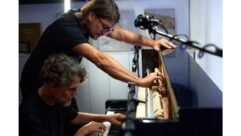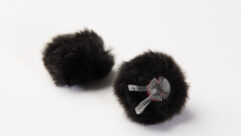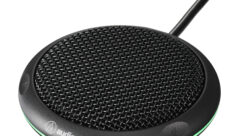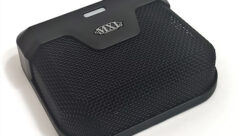Boundary Microphones
Apr 1, 2003 12:00 PM,
Chris Steinwand
Sound concepts are really deceptively simple. To make sound, you have to move air. For humans that’s the job of our vocal cords. To hear sound, you have to receive that moving air, and that’s the job of our eardrums. The brain controls both processes and performs the job of making sense of it all. Simple. In electroacoustics it is not so simple. One fundamental difference is that there is no brain to process the production and reception processes — not yet at least, though advances in artificial intelligence and digital signal-processing technology inch frighteningly closer every day. So a loudspeaker — a purely mechanical device and a fairly low-tech one at that — can only reproduce the intended input with limited fidelity because it is subject to its own mechanical limitations. Microphones, another simple mechanical transducer, don’t have the advantage of a brain telling it what to listen to and what to ignore. In sound reinforcement or recording, the long trip between the loudspeaker and the microphone is affected by room acoustics, atmospheric conditions, and physical elements in the space where the devices are used.
The physical housing and mounting of the diaphragm element in a microphone determines its pickup pattern, whether cardioid (or hypercardioid or supercardioid) or omnidirectional. But just like the ear, it’s going to pick up a combination of direct and reflected sound, and the resulting phase cancellations and summations determine the ultimate sound quality that is received. The difference with our ears, again, is the gray matter — our brain’s signal-processing capability helps us determine what the sound should sound like and compensates for a certain degree of phase interaction that allows us to make sense of the input signal. The microphone in a sound system has no such capability.
In any room, sound travels to the microphone by two paths: by direct path to the mic and as a result of being reflected off any hard surfaces in the room. Many surfaces will diffuse and scatter sound, which results in multiple reflections. Reflections travel a longer path to the microphone, and so they arrive later in time, and that is the cause of multiple phase interactions. Both the direct and delayed sounds ultimately combine at the microphone diaphragm.
At frequencies where the direct and delayed sounds are in-phase (coherent), the signals add together, doubling the pressure and boosting the amplitude 6 dB. At frequencies where the direct and delayed signals are out-of-phase, the signals cancel each other, creating a dip or notch in the response. That results in a series of peaks and dips in the overall frequency response, creating a comb filter effect, producing unnatural sound.
To solve this problem, it’s necessary to shorten the delay of the reflected sound so that it arrives at the microphone at the same time the direct sound does. If a conventional microphone is placed extremely close to the reflective surface, the direct and reflected sound paths become nearly equal. There is still a short delay in the reflected sound because the center of the microphone diaphragm (where the two sound paths combine) is slightly above the surface. Consequently, high frequencies (wavelengths relative in size to the distance of separation) may be canceled to some degree.
HOW THEY WORK
The physics behind this phenomenon derive from principles of basic fluid dynamics and aerodynamics. Original research was conducted by the German physicist Ludwig Prandtl in the early 1900s. His research showed that as a fluid (in this case, air) moves past an object, the molecules of the fluid near the object are disturbed and move around the object. Aerodynamic forces are generated between the fluid and the object. As the fluid moves past the object, the molecules right next to the surface stick to it. The molecules just above the surface are slowed down by their collisions with the molecules sticking to the surface. These molecules in turn slow down the flow just above them. The farther one moves away from the surface, the fewer the collisions are affected by the object surface. This creates a thin layer of fluid near the surface in which the velocity changes from zero (at the surface) to the free stream away from the surface. Engineers call this the boundary layer because it occurs on the boundary of the fluid.
In 1978 sound engineers Ed Long and Ron Wickersham recognized the effects of a boundary layer in sound recording. In studying the behavior of flushmounted microphones, they discovered that within a few millimeters of a large surface, sound levels from a pair of equal level signals add coherently because, in close proximity to the surface, the particles are still in phase as they accelerate after being brought to a stop by the boundary, thus creating what is called a pressure field, or pressure zone, in the boundary layer. The result is a 6 dB increase in acoustic pressure. In this pressure field, the instantaneous pressure is uniform in all directions, with no direction of propagation. A microphone diaphragm will therefore have 6 dB higher sensitivity when placed in the pressure zone than an equal microphone placed in the free field. Diffuse sound will not be reflected at a plane boundary because diffuse sound has no direction (per definition). This microphone will therefore give direct sound 3 dB higher level than diffuse sound. If used outdoors, these microphones will perform better than conventional microphones with regard to wind noise, as the wind velocity in principle is zero on the surface of the ground.
The pressure zone can be defined another way: The pressure zone is the distance from the boundary that the microphone diaphragm must be placed to achieve the desired high-frequency response. The closer the diaphragm is placed to the boundary (up to a point), the more extended is the high-frequency response.
This approach has many benefits. First, there is the 6 dB increase in sensitivity caused by the pressure zone itself. There is also consistent tonal reproduction independent of the distance of the mic to the source. Because the reflected path length stays equal to the direct path length, there is no change in tonal quality as the source moves. Many users report a lack of off-axis tonal coloration as a result of the small size of the diaphragm. Because of the necessarily small size, the microphone can be inconspicuous in application.
COMMON APPLICATIONS
Because of this combination of benefits, the boundary mic has been popular for a multitude of applications.
The boardroom conference table is probably the most common use. This environment usually has several reflective surfaces and, during a conference, has more than one person talking simultaneously. The use of a boundary mic eliminates the need to mic each person separately and reduces the need to deaden the room.
Boundary mics are also frequently used on podiums and church altars. In these cases, the advantage is not so much the ability to negate reflective sound waves but is the ability to clearly pick up a voice without having to be in close proximity to it. That frees the talker to move around and to gesture without moving out of range or hitting the mic.
Another typical application is in the miking of percussive instruments. The advantage of using boundary mics on a drum set are similar to the advantages for boardroom use — you’ll need fewer mics to do the job.
The piano is another percussive instrument that is commonly miked with boundary mics. Typically, only one is needed, or two for stereo, and their boundary plates mount unobtrusively under the piano lid. In this application, you gain from all the advantages mentioned previously. The piano, like other percussive instruments, has those sharp transient peaks as well as the much softer undertones that add depth and realism to the reinforced or recorded sound.
If you’ve ever been involved with live theater, then you know that the stage is often miked by laying several microphones on the floor across the front of the stage and sometimes hanging mics strategically over the stage area. The problems with hanging mics are obvious. Even condenser mics are going to be directional to a degree and proximity sensitive. Laying regular mics on the floor can be problematic for a couple for reasons. First, because of their design, when placed against a flat, reflective surface, they will produce odd distortions and cancellations. Second, they can be damaged if stepped on. Boundary mics solve all of these problems and reduce the number of mics needed.
Although most boundary mics follow the familiar format of a condenser element mounted to a boundary plate and covered with a protective screen, there is one significant variation. Recessed boundary mics aren’t attached to the plate and don’t usually have a protective screen. These mics are designed for fixed-install mounting in a wall, ceiling, tabletop, podium, and so on. They are designed to be visually discreet yet provide the same advantages and characteristics of traditional boundary mics. Common applications for this type of mic are surveillance, intercom systems, lecterns, and so on.
THE MANUFACTURERS
Most of the major microphone manufacturers (and some not so major) offer a selection of boundary mics.
AKG is a well-known manufacturer of all types of microphones and headphones. It has boundary mics geared toward all of the most common applications, like piano, drums, and boardrooms. It even has different models for a grand piano versus upright and a snare drum versus kick drum. The C 562 BL is housed in a round, very low-profile boundary plate and is commonly used for acoustical guitar and choir miking. The C 547 BL is a studio-quality, hypercardioid mic housed in a crush-proof case for high-quality miking where durability is important. The C 680 BL is a cardioid polar, boardroom model that comes equipped with adhesive tape that promises not to mar or stain delicate finishes. It also comes in a repaintable housing.
Astatic is a microphone specialty company with a few offerings in the boundary mic category. The 201 and 202 models are small hemispherical condenser mics encased in a short tube for recessed mounting. They come without a reflector plate, so they can be mounted discreetly on a podium, in a ceiling, or on other such surfaces. The Astatic 901 is a traditional surfacemounted boundary mic suitable for use on a conference room table, stage floor, and so forth.
Audio-Technica weighs in with 14 models of boundary mics. They are divided into three model groups. The AT series includes an assortment of uni- and omnidirectional models. Some, including the AT851Rx, have interchangeable mic elements that can take you from a 100-degree pattern to 360-degree coverage. The AT841 and 849 contain in-line power while the 851 comes in a phantom-power/battery version or a phantom-power-only model. The ES series include two recessmounted models. The ES945 and 947 can be flushmounted. The 961 and 961P have plug connections mounted directly on the back, so the 961P, for example can be plugged directly in to a TRS mic input or female end of a cable, allowing for easy mounting and removal. The Pro 42 and Pro 44 models are, as implied in their names, designed for professional applications where both quality and durability are essential. The AT891R/C is a boundary mic with an ultraquiet electronic switch that can be set to any of three operating modes: touch-on/touch-off, touch-to-talk, and touch-to-mute, with a red LED on top that indicates when the mic is on.
Audix is well known for its drum and percussion miking products. Because boundary mics are often used to mic percussive instruments like drums and piano, it’s not a surprise that the company offers a selection of boundary mics, also. It has two models. The ADX-70 is a low-profile table- or ceilingmount model with a cardioid condenser element. Electronics are built into the unit, but it still requires phantom power of 9V to 52V. The ADX-60 is also a cardioid condenser element but is housed in a durable boundary plate suitable for surfacemounting, such as the underside of a piano lid or a stage floor.
Avlex offers the BM91 boundary mic in several configurations to serve many applications. The mics were designed primarily for tabletop use but can be used in any boundary mic application. Model variations include cardioid and omnidirectional pickup patterns. Each of the separate models is available in a black or white finish, but the company also advertises that each mic comes with a custom paint mask that would allow the unit to really blend in on certain applications. Variations in the sturdy steel casing are also available for stage- or floormounting.
Beyerdynamic has several boundary microphones in its product lineup. The MPC 22 and 23 are flushmount units for tabletop/ ceilingmounting. The main difference between them is that the MPC 22 has a half-cardioid polar pattern, which allows for directional coverage, and the MPC 23 uses an omnidirectional element with a 180-degree coverage pattern. The remaining models — the MPC 65, 66, and 67 — are all encased in boundary plates. The MPC 66 has a slightly better low-end frequency range than the 65 and 67. Otherwise, the essential differences are in the type of pickup pattern. The MPC 65 uses a semicardioid, the MPC 66 uses a half-spherical, and the 67 is actually available in a few different versions, but the base model produces a half-cardioid polar pattern. The MPC 67 also has “intelligent” features like selective bass roll-off and push-button modes for mute, push-to-talk, and so on.
CAD Microphones has one boundary microphone in two color variations: black or white. The ST-100/ST-100W is a tabletop or surfacemount unit with a unidirectional half-cardioid condenser element. The ST-100 is a transformerless unit, so it’s completely self-contained, except for the phantom power supply. The durable die-cast zinc base makes this unit suitable for stage-floor mounting or other applications where getting stepped on is a possibility.
Although best known for its legendary power amplifiers, Crown Audio has the distinction of being the first to market a boundary mic in 1980. The PZM-30D is the base model. Frequency response is 20 Hz to 20 kHz, with a switchable filter that allows you to choose between a flat or “bright” sound. The PZM-6D is similar to the 30D, except with a smaller plate for less conspicuous mounting. Both are commonly used for overhead miking and under-lid piano miking. The PZM-20R is a flush-mount model available in black or white. Response is 20 to 20 kHz, but it has a built-in filter that rolls off the low end and puts a little emphasis on the higher band. This treatment is intended to optimize the mic for speech pickup. Its entry-level model is the PZM-185. All of these mics are condenser type and thus require a power supply. One nice feature of the 185 is its ability to draw power from a single AAA battery. That allows use with semi-pro mixers and with consumer products like video cameras. For strictly semipro to nonprofessional applications, the company makes the Sound Grabber II. It’s still a true boundary mic, but it comes with a mini phone plug and requires that AAA battery. It also delivers an unbalanced 1,600ž signal.
Perhaps best known for its audio test and measurement systems, Gold Line also manufactures the CBM1 boundary microphone. The CBM1 is an omnidirectional electret condenser mic that includes the element and power supply with battery integrated into a single unit. It includes several filter switches for high-frequency boost or cut (±6dB).
Peak Audio of Australia, not to be confused with Peak Audio division of Cirrus Logic (of CobraNet fame), makes the DB-271B boundary mic, an omnidirectional flat design that makes it an appropriate choice for tabletop applications such as boardroom meetings. It is also well suited for podium use. It has bass cut and boost switching and is housed within a heavy zinc plate for durability.
Japanese microphone manufacturer Sanken has recently introduced the CUB-01 boundary microphone, which offers a new design. Although small (32 mm diameter, 12 mm height, 0.12 pounds weight) the sound is comparable with much larger microphones. The CUB-01 is designed for use in many situations, from TV and film field shooting to broadcast studio production and conference table recording. Because of its small size, it is easy to conceal from the camera and can be positioned in a variety of environments — for example, attached to the ceiling of a car with two-sided sticky tape.
The Schoeps BLM 3 boundary mic has a small pressure transducer capsule with a 5 mm plate that creates virtually no effect on the sound pickup. Its low-profile power supply fits flatly into the plate so that it creates no interruption to the hemispherical pickup pattern.
Everyone knows that Shure is a major microphone manufacturer, so it’s no surprise it has a broad selection of boundary microphones. The MX or Microflex series of boundary mics has a total of 21 models, or more accurately, there are 7 models, each available in 3 variations. All of these models have features like programmable, silent membrane switches; logic inputs and outputs; and LED indicators. While each model is available as a cardioid, a supercardioid, and an omnidirectional, the condenser cartridges are also interchangeable, so if the application changes, you can modify the mic without having to replace it. The Easyflex line comes in similar variations as the Microflex, though with a smaller footprint and without the interchangeable condenser elements. The Microflex models also come with an in-line preamp, so no phantom power is needed and you can plug them in to consumer products.
Although boundary mics have only been available for a little over 20 years, they have become a mainstay in any sound installer’s bag of tricks for solving many audio and installation problems.
Chris Steinwand is a marketing veteran of the pro audio/video industry, a freelance writer, and the director of Stonejam Consulting. You can reach him through e-mail at [email protected]. Thanks to Crown Audio for background material for this article.
For More Information
AKG
www.akgacoustics.com
Ž 223
Astatic
www.astatic.com
Ž 224
Audio-Technica
www.audio-technica.com
Ž 225
Audix
www.audixusa.com
Ž 226
Avlex
www.avlex.com
Ž 227
Beyerdynamic
www.beyerdynamic.com
Ž 228
CAD Microphones
www.cadmics.com
Ž 229
Crown Audio
www.crownaudio.com
Ž 230
Gold Line
www.gold-line.com
Ž 231
Peak Audio
www.peakaudio.com.au
Ž 232
Sanken
www.sanken-mic.com
Ž 233
Schoeps
www.schoeps.de
Ž 234
Shure International
www.shure.com
Ž 235
Ž Circle this number on Reader Service Card or visit freeproductinfo.net/svc










